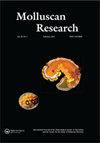在澳大利亚西部的罗特尼斯岛,有一种重复出现的海象(腹足纲:腹足科)
IF 0.6
4区 生物学
Q3 ZOOLOGY
引用次数: 1
摘要
在西澳大利亚罗特尼斯岛的小阿姆斯特朗湾和北角之间的潮间带石灰岩台地上,有许多(但不是全部)重复出现的海蛞蝓种群。采用样带/样方法测量了2020/2021年南方夏季毛螺旋体的密度。2020年12月无个体存在,但2021年1月17日有种群,平均密度为16.5±1.6 (SE)只/ m−2。赤沙样区密度低(2.6±3.2 inds m−2),海草样区密度低(2.0±1.4 inds m−2),混合藻类密度高(18.2±1.8 inds m−2),以褐藻类为主(18.2±1.8 inds m−2),在少量沙藻混合样区或沙南极样区密度最高(27.2±14.3 inds m−2)。据估计,其种群数量约为60万只。该物种在2月份还存在,但在2021年3月底就消失了。小阿姆斯壮湾和北角的种群为更好地了解毛芽孢杆菌的生物学和更广泛的种群兴衰问题提供了良好的机会。本文章由计算机程序翻译,如有差异,请以英文原文为准。
A recurring population of the sea hare Bursatella hirsuta (Gastropoda: Aplysiidae) at Rottnest Island, Western Australia
ABSTRACT In many, but not all, years a recurring population of the marine aplysiid Bursatella hirsuta occurs on an intertidal limestone platform stretching between Little Armstrong Bay and North Point at Rottnest Island, Western Australia. Using a transect/quadrat method, we measured densities of B. hirsuta during the austral summer of 2020/2021. No individuals were present in December 2020, but a population with a mean density of 16.5 ± 1.6 (SE) inds m−2 was present on 17 January 2021. Density was low in bare sand (2.6 ± 3.2 inds m−2) and in the seagrass Amphibolis antarctica (2.0 ± 1.4 inds m−2), high in mixed algae, mostly Phaeophyceae (18.2 ± 1.8 inds m−2) and greatest (27.2 ± 14.3 inds m−2) in a small number of quadrats with a mixture of sand and algae or sand and A. antarctica. The population was estimated at >600,000 individuals. The species was present in February but had disappeared by late March 2021. The population at Little Armstrong Bay and North Point provides a fertile opportunity for developing a better understanding of the biology of B. hirsuta and broader questions of boom-and-bust populations.
求助全文
通过发布文献求助,成功后即可免费获取论文全文。
去求助
来源期刊

Molluscan Research
生物-动物学
CiteScore
1.80
自引率
10.00%
发文量
27
审稿时长
>12 weeks
期刊介绍:
Molluscan Research is an international journal for the publication of authoritative papers and review articles on all aspects of molluscan research, including biology, systematics, morphology, physiology, ecology, conservation, biogeography, genetics, molecular biology and palaeontology.
While the scope of the journal is worldwide, there is emphasis on studies relating to Australasia and the Indo-west Pacific, including East and South East Asia. The journal’s scope includes revisionary papers, monographs, reviews, theoretical papers and briefer communications. Monographic studies of up to 73 printed pages may also be considered.
The journal has been published since 1957 (as the Journal of the Malacological Society of Australia until 1993). It is free to members of the Malacological Society of Australasia and the Society for the Study of Molluscan Diversity.
 求助内容:
求助内容: 应助结果提醒方式:
应助结果提醒方式:


